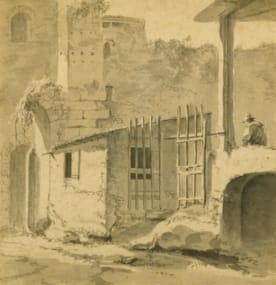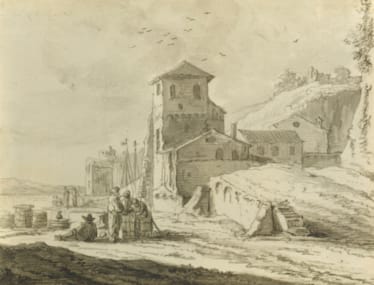
homas Wyck
(Beverwijk near Haarlem 1616 - Haarlem 1677)
 Biography
Biography An Italian Courtyard with a Gateway and Seated Figure
Biography
Thomas Wyck, also known as Thomas Wijck, was a Flemish painter who was trained in Haarlem. He journeyed to Italy, presumably by 1640, the year in which a ‘Tommaso fiammingo, pittore’ (Thomas the Fleming, painter) is documented as residing in Rome in the Via della Fontanella. In 1642 Wijck was once again in the northern Netherlands, enrolled in Haarlem’s Guild of St Luke. It is unlikely that the artist was again in Rome in the spring of 1644 (as Busiri Vici maintained), given the fact that on 22 May of that year he was married in Haarlem. His presence in his native city is further documented in 1658, 1659, 1669 and 1676.
Given the lack of dated works by Wyck, it is difficult to establish which paintings he executed in Rome, since even after his return to the Netherlands he painted Dutch Italianate themes, using black chalk and wash drawings done from life in Rome, a large number of which have survived. It is likely that the paintings most directly reflecting the work of northern artists active in Rome c. 1640 and those depicting the city’s landscape with the greatest sense of immediacy and realism date from his Roman period and the years shortly thereafter. Works that can be dated to the 1640s include the View of the Aracoeli (Munich, Alte Pinakothek), the Market Place at the Portico d’Octavia (private collection), the Roman Courtyard with a Blacksmith (private collection) and the Washerwomen in a Courtyard (Warsaw, National Museum), for which there is a preparatory drawing of a deserted courtyard (Amsterdam, Rijksmuseum). Whatever Wyck’s training, these paintings show that during his stay in Rome, Wijck was aware of the late works of Andries Both, such as Both’s Musicians in a Courtyard (Munich, Alte Pinakothek). Wyck also harked back to the works of Pieter van Laer (Il Bamboccio), whose paintings were despatched regularly to Haarlem from Rome, so Wyck may have seen examples even before travelling to Italy. Through examples of van Laer’s work, such as Travellers in a Courtyard (Florence, Uffizi) and Flagellants (Munich, Alte Pinakothek), Wyck learnt to structure his characteristic views of courtyards and small squares framed, in the foreground, by archways and enclosed, in the background, by rooftops and loggias.
Wyck presented a ‘backstreet’ view of Rome, bereft of the great Classical and Renaissance monuments that were the main focus of attention for other Dutch Italianates and, more especially, for their northern clientele. It is rarely possible to identify specific locations in his works, but despite or perhaps because of this, Wyck’s views of the city, undoubtedly composed in the studio according to specific structural principles, seem more convincing and more realistic than those created by the Italianate artists of the second half of the 17th century. Scenes of Roman popular life crowded with small figures, so typical of the Bamboccianti (followers of van Laer), are of relatively little importance when compared with Wijck’s overwhelming interest in the urban setting. Yet some of Wijck’s paintings, for example the Morra Players (Vienna, Gemäldegalerie der Akademie der bildenden Künste) and the Peasants in a Courtyard (Philadelphia, PA, Museum of Arts), show strong connections with the bambocciata paintings (low-life scenes) of the early 1640s and in particular with the work of the so-called Master of the Small Trades, who may perhaps be identifiable with the young Jan Lingelbach.
There is a much greater concentration on landscape elements in paintings such as Washerwomen (Hannover, Niedersächsisches Landesmuseum) and View of the Ponte Molle (Brunswick, Herzog Anton Ulrich-Museum), which is partly based on an engraving of the same subject by Jan Both. A vital part of Thomas Wyck’s development as a landscape artist was undoubtedly the example set by Jan Asselijn, who was probably active in Rome between 1639 and 1643, and perhaps also that set by the much older artist Filippo Napoletano, who, in works such as the Mill (Florence, Pitti), had earlier displayed the same propensity for realism and the same method of structuring his compositions.
In the course of his travels in Italy Wyck probably also visited Naples. Though unconfirmed by documents, there are a number of views by his hand relating to the Gulf of Naples, for example the small and highly realistic View of the Bay of Naples (Naples, Causa private collection) and the imaginary views of harbours showing Mt Vesuvius and the Torre di S Vicenzo in the background with figures of travellers and exotic Orientals in the foreground (e.g. Imaginary View of a Port, Munich, Alte Pinakothek). These imaginary harbour and shore scenes enriched with picturesque figures were highly prized by 18th-century collectors and connoisseurs. Wijck’s example may have inspired other northern Italianates to enrich their thematic repertory with Neapolitan subjects.
In his last years Wyck produced works closely linked in style and subject-matter to Dutch genre painting. They are completely independent of his Italianate works, while still preserving some of the artist’s earlier compositional devices. Interior scenes with alchemists (e.g. Brunswick, Herzog Anton Ulrich-Museum; Munich, Alte Pinakothek, 856) were typical of the artist according to Horace Walpole. Walpole also recalled the artist’s visit to London, during which he is said to have painted views of the city before the Great Fire of 1666 (e.g. Badminton House, Glos) and also depicted the fire itself (e.g. Chatsworth, Derbyshire). This journey probably took place between 1660 and 1668, a period during which Wyck is not recorded in his homeland.
Collections
Wyck is represented in the following collections: Rijksmuseum, Amsterdam; Courtauld Institute of Art, London; Ashmolean Museum at the University of Oxford; Fitzwilliam Museum at the University of Cambridge; Kunsthistorisches Museum, Vienna; Museum der Bildenden Künste, Leipzig; Musée des Beaux-Arts de Caen, France; Hermitage Museum, Saint Petersburg; National Gallery of Art, Washington D.C.; Fine Arts Museums of San Francisco; Harvard University Art Museums, Massachusetts, amongst others.











